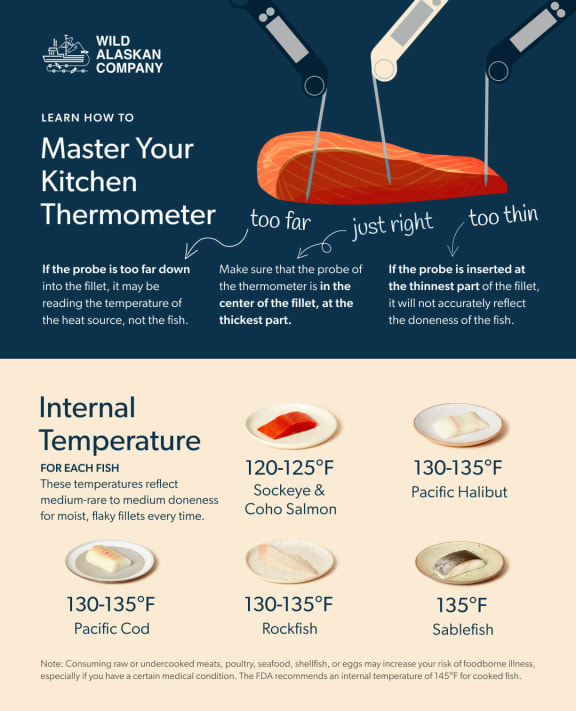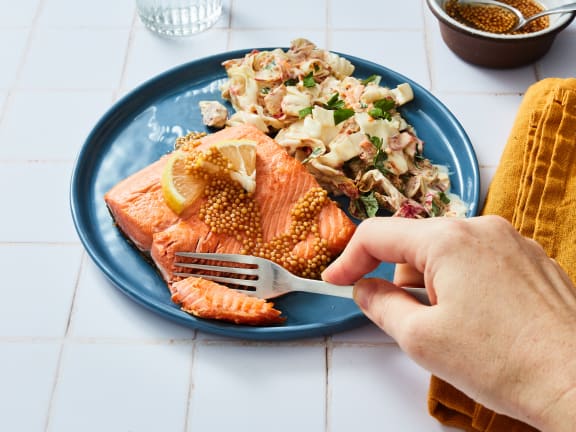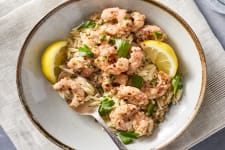The optimal internal temperature is unique to each species, depending on factors like fat content and protein structure.
Keep in mind that “optimal,” ultimately, should reflect your personal preference in texture and doneness. But we have some general rules of thumb with cook temperature to get you closer to perfection.
Wild Salmon Internal Temp: 120 degrees F to 125 degrees F
 Because wild salmon is so much leaner than farmed Atlantic salmon, it benefits from being slightly underdone, compared to what you might be accustomed to when cooking salmon.
Because wild salmon is so much leaner than farmed Atlantic salmon, it benefits from being slightly underdone, compared to what you might be accustomed to when cooking salmon.
For a fillet of sockeye or coho that’s flaky and moist, we recommend cooking it to a medium-rare doneness — for wild salmon, internal temperatures anywhere between 120 degrees F and 125 degrees F will get you there. At this sweet spot, a salmon fillet will still be a little raw in the center, but should be firm to the touch and flake easily with a fork.
When cooking wild salmon above this range of internal temperature, you can expect the fillets to be drier in texture with a firmer flake. If you're having trouble dialing in the doneness of wild salmon, you may also want to consider trying a few different techniques that will help keep the salmon moist and flaky as it cooks.
Pacific Halibut Internal Temp: 130 degrees F to 135 degrees F
 When cooking a lean fillet like Pacific halibut, you’ll ideally want to cook it to medium doneness. At this level of doneness, Pacific halibut fillets will be firm, flake easily with a fork, and nearly opaque in their centers. Aim for an internal temperature anywhere between 130 degrees F and 135 degrees F.
When cooking a lean fillet like Pacific halibut, you’ll ideally want to cook it to medium doneness. At this level of doneness, Pacific halibut fillets will be firm, flake easily with a fork, and nearly opaque in their centers. Aim for an internal temperature anywhere between 130 degrees F and 135 degrees F.
Any lower than this, and halibut won’t flake easily with a fork. Cooked past 135 degrees F, Pacific halibut can become quite tough and difficult to flake.
Pacific Cod Internal Temp: 130 degrees F to 135 degrees F
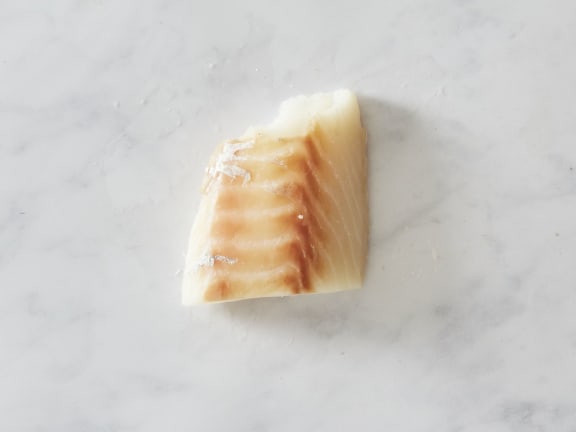 Pacific cod is also ideally cooked to anywhere between 130 degrees F and 135 degrees F for medium doneness. At this temperature, a fillet of Pacific cod will be firm and flake easily with a fork.
Pacific cod is also ideally cooked to anywhere between 130 degrees F and 135 degrees F for medium doneness. At this temperature, a fillet of Pacific cod will be firm and flake easily with a fork.
If you’re cooking to this range of internal temperature but are still having trouble cooking Pacific cod perfectly, check out our blog post to read about how the recipe team at Wild Alaskan helped a member troubleshoot problems she was having with tough Pacific cod.
Internal Temp for Sablefish: 135 degrees F
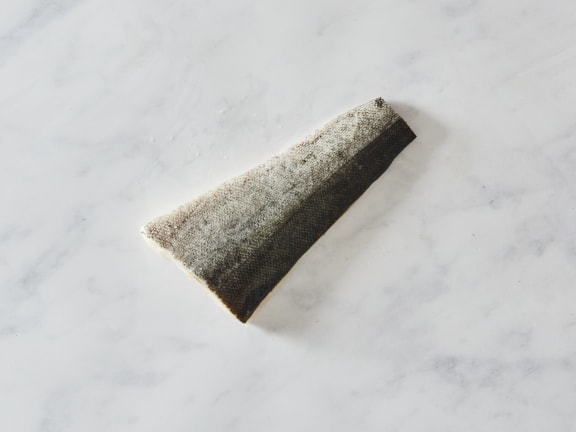 When cooking sablefish, aim for an internal temperature of 135 degrees F. Its rich fat content makes it an incredibly forgiving fillet to cook, so that even if you’re cooking sablefish past this mark, it’ll be flaky and tender.
When cooking sablefish, aim for an internal temperature of 135 degrees F. Its rich fat content makes it an incredibly forgiving fillet to cook, so that even if you’re cooking sablefish past this mark, it’ll be flaky and tender.
Internal Temp for Rockfish: 130 degrees F to 135 degrees F
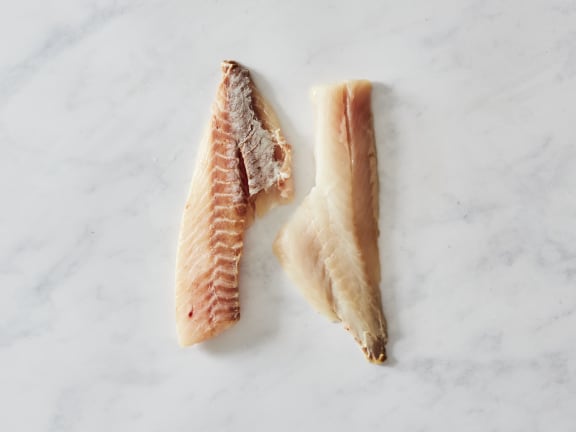
Rockfish fillets become flaky and tender around the 130 degrees F to 135 degrees F internal temperature mark. However, it’s not going to be easy to get a temperature read on these fillets because of their thin profile. Instead, check on doneness with a fork to see if it flakes easily and is opaque through the thickest part of the fillet.
Keep in mind: Though rockfish is a lean species, it doesn’t toughen up like Pacific cod or Pacific halibut when overcooked. Because of this, the internal temperature may not be as relevant when cooking this species.
Wild Alaskan Pollock Internal Temp: 130 degrees F to 135 degrees F
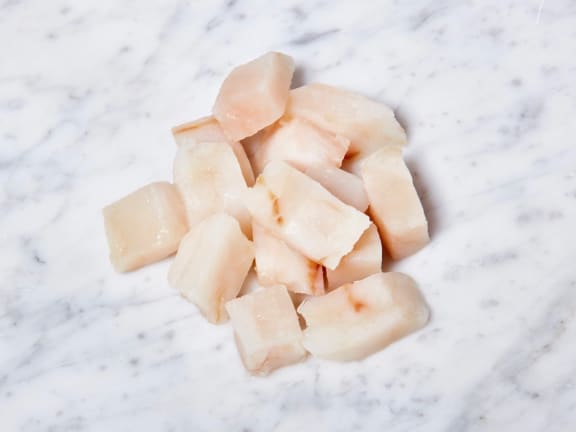 Because Wild Alaska Pollock Quick Cuts are portioned into smaller bites, you’ll be better off determining their doneness by flaking with a fork and checking to see if the pieces are opaque through their centers.
Because Wild Alaska Pollock Quick Cuts are portioned into smaller bites, you’ll be better off determining their doneness by flaking with a fork and checking to see if the pieces are opaque through their centers.
However, if you are keen on checking their internal temperature with an instant-read thermometer, they should be at least 130 degrees F to 135 degrees F in the center.
When You’ll Want to Cook to 145 degrees F
If you’re pregnant or need to consume a low-microbial diet for any other reason, the optimal internal temperature of all seafood, including shellfish, is 145 degrees F at its thickest part, full stop. That’s the internal cook temp that the USDA has determined to significantly reduce your risk of food-borne illness.
Anytime you cook a fillet to a temperature below 145 degrees F or consume it raw — a similar rule applies to meat, poultry, eggs, and shellfish as well — it opens you up to the risk of contracting a food-borne illness.
Note: Consuming raw or undercooked meats, poultry, seafood, shellfish, or eggs may increase your risk of foodborne illness, especially if you have a certain medical condition. The FDA recommends an internal temperature of 145°F for cooked fish.
What Is Carryover Cooking?
Carryover cooking is basically the cooking that happens after you pull seafood from the heat, since the proteins still retain some of the residual heat from your cooking surface even after it’s on a plate. The hotter your cooking surface or cooking method, the more carryover cooking will have an effect on the internal temperature of seafood after it has rested for several minutes.
For example, pulling a fillet of salmon from a hot grill at 120 degrees F can leave you with a fillet that registers at closer to 130 degrees F by the time that carryover heat dissipates. If you think that carryover cooking is leaving you with fillets that are more cooked than you’d like, try pulling it from the heat when it’s a few degrees cooler than our optimal recommendation.
Again, these temperatures are suggestions that will leave you with fillets that are tender, neither underdone or overcooked. If you like something a little more or less cooked, you can go a little higher or lower than these recommendations.
